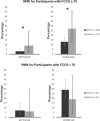Words-in-Noise Test Performance in Young Adults Perinatally HIV Infected and Exposed, Uninfected
- PMID: 32004075
- PMCID: PMC7229777
- DOI: 10.1044/2019_AJA-19-00042
Words-in-Noise Test Performance in Young Adults Perinatally HIV Infected and Exposed, Uninfected
Abstract
Purpose The purpose of this study was to compare Words-in-Noise (WIN) data between young adults with perinatal HIV (PHIV) infection and those with PHIV exposure but uninfected (PHEU) and to evaluate associations between antiretroviral therapy (ART) exposures and WIN data. Method The WIN test and cognitive function were assessed in participants of the Pediatric HIV/AIDS Cohort Study Adolescent Master Protocol Up. Impaired WIN (IWIN) performance was defined as a signal-to-babble ratio of > +10 dB. Cognitive function was determined based on fluid cognition composite scores (FCCSs) and crystallized cognition composite scores, and < 70 was considered a fluid or crystallized cognitive impairment. Log binomial models were used to calculate the relative risks of IWIN between PHIV and PHEU. Results PHIV (n = 334) and PHEU (n = 52) participants had similar WIN thresholds and IWIN percentages. For young adults with FCCS ≥ 70, participants with PHIV were less likely to have IWIN for the better ear and worse ear as compared to participants with PHEU. For young adults with FCCS < 70, there was no association between HIV status and risk of IWIN for the better ear or worse ear. For those adults with crystallized cognition composite score of ≥ 70, young adults with PHIV were less likely to have IWIN for the better ear than young adults with PHEU; there was no association between HIV status and IWIN for the worse ear. For young adults with PHIV without a Centers for Disease Control and Prevention Class C diagnosis, a longer combination ART duration was associated with a higher risk of IWIN for the better ear. Conclusions For those without cognitive impairment, young adults with PHEU had poorer WIN thresholds than those young adults with PHIV. In young adults with PHIV who had no prior Centers for Disease Control and Prevention Class C diagnosis, a longer combination ART duration was associated with IWIN only in the better ear.
Figures


References
-
- Bankaitis A. E., & Schountz T. (1998). HIV-related ototoxicity. Seminars in Hearing, 19(2), 155–163.
-
- Bisiacchi P. S., Suppiej A., & Laverda A. (2000). Neuropsychological evaluation of neurologically asymptomatic HIV-infected children. Brain and Cognition, 43(1–3), 49–52. - PubMed
-
- Blair J. C. (1985). The effects of mild sensorineural hearing loss on academic performance of young school-age children. The Volta Review, 87, 87–93.
-
- Garvie P. A., Zeldow B., Malee K., Nichols S. L., Smith R. A., Wilkins M. L., Williams P. L., &. Pediatric HIV/AIDS Cohort Study (PHACS). (2014). Discordance of cognitive and academic achievement outcomes in youth with perinatal HIV exposure. The Pediatric Infectious Disease Journal, 33(9), e232–e238. - PMC - PubMed
MeSH terms
Grants and funding
LinkOut - more resources
Full Text Sources
Medical
Miscellaneous

